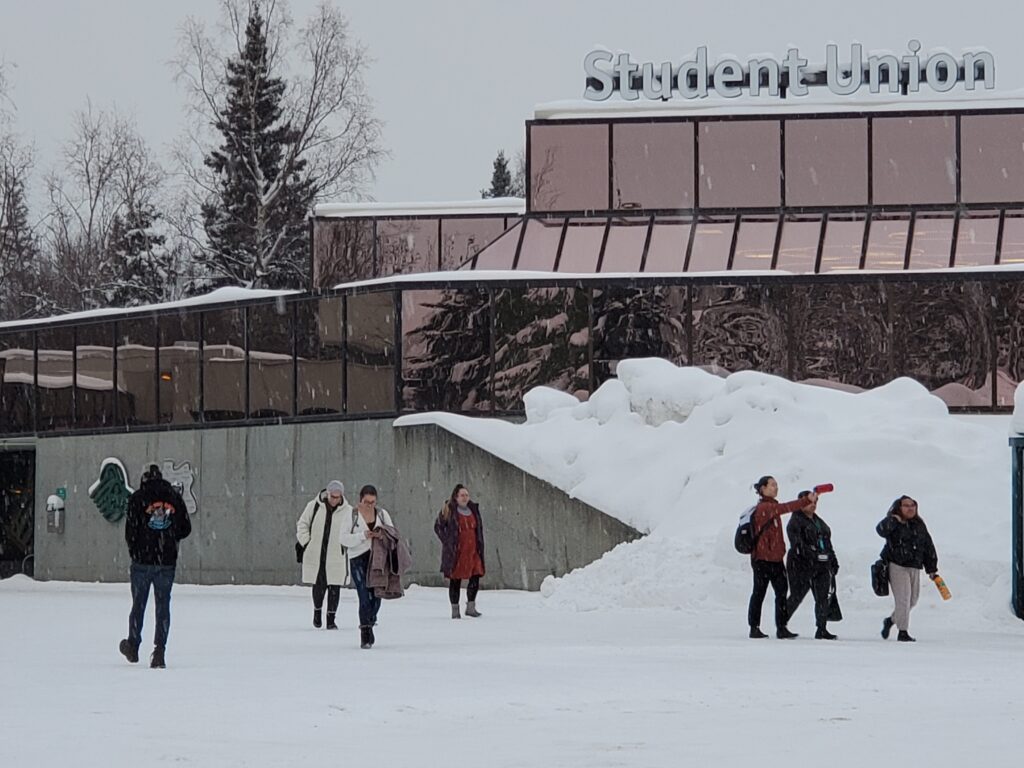University of Alaska Anchorage students walking outside UAA Student Union on Feb. 7, 2023. (Photo by Yereth Rosen/Alaska Beacon)
Alaska lawmakers approved legislation to increase eligibility for the Alaska Performance Scholarship, a merit-based program that provides financial assistance to students pursuing higher education or technical training in-state. House Bill 148 also raises the maximum award amount.
Since launching in 2011, the Alaska Performance Scholarship has funded over $122 million scholarships for Alaskan students. However, in recent years, the share of public high school graduates who are eligible has dropped significantly. In 2023, 17% of graduates were eligible, compared to 30% of graduates in 2011.
Under HB 148, students will only need either a high grade point average or test score to qualify, not both. Joe Pavia-Jones, the chair of the University of Alaska’s Coalition of Student Leaders and a third-year at the University of Alaska Anchorage, received one of the scholarships. He qualified in 2020, when the testing requirement was waived.
Pavia-Jones said the waiver allowed him to receive more money, which made it possible for him to attend the university.
“I got bumped up from the Level 3 up to Level 1,” said Pavia-Jones, referring to the tiers of award money available through the scholarships. “It made it more important to me, because I was able to get a lot more money.” If test scores affected eligibility in 2020, Pavia-Jones’ scholarship would have been halved. That sum, he says, likely would not have been enough incentive to stay in Alaska for college; before receiving the scholarship, he was interested in attending college in the Lower 48.
The maximum Level 1 scholarship would increase nearly 50%, from $4,755 to $7,000.
One of the scholarship program’s primary goals is to keep high-achieving students in Alaska — statistically, Alaskans who attend college in-state are more likely to stay in the state after graduation.
Despite this goal, the share of eligible high school graduates using the program has declined since 2016. The majority of students who are eligible do not use the scholarships, and over half of those students choose not to use it because they do not want to attend a college or vocational school in Alaska.
This disinterest in Alaska schools occurs against the backdrop of Alaska’s population decline, as more people continue to leave Alaska than arrive here, which has occurred for 11 consecutive years. Students who leave Alaska for college will “probably get jobs somewhere else… they’ll get connected somewhere else,” Pavia-Jones said. “They just don’t come back.”
By increasing the award amount, HB 148 would potentially make APS more appealing to eligible students.
The bill would also increase awareness about the scholarships among high schoolers by notifying students about the program earlier. Tatiana Petrykievicz, an administrative assistant for the UAA’s student advising center and a recent graduate of the university, wasn’t aware of the scholarship when she was in high school. If she had known about it, then she “definitely” would have been interested, she said. “I think that back then I would’ve had the scores for it,” she said. “I don’t think I was completely aware of it when I was enrolling.”
A notable change to the scholarship program under HB 148 is the expansion of secondary education options—students would be able to use the scholarship to attend career and technical schools. Additionally, students’ eligibility after graduation is extended from six years to eight years and the scholarship would also be made more accessible for part-time or graduate students. If a student raises their GPA while studying at a postsecondary institution, they would be eligible for an increased award level.
In addition to the adjustments to the scholarships, HB 148 makes more funding accessible for Head Start, a program that provides child care and early education to over 3,000 children from low-income families in Alaska. Head Start also provides health and dental screenings for children, which are often inaccessible in remote parts of the state. The federal government pays for 80% of Head Start’s funding, and under HB 148, the state would match the remaining 20%, which is $5.2 million for this year.
At the end of the legislative session in May, the Senate voted 20-0 for the bill. The House adopted the Senate version 39-1, with Rep. David Eastman, R-Wasilla, voting no. Now, the bill is waiting to be signed, vetoed, or allowed to become law without a signature by Gov. Mike Dunleavy.
Rus’sel Sampson, a researcher at UAA’s Alaska Justice Information Center, said the program is important for the state’s future. Her daughter, a senior in high school, was recently informed about the scholarships by her adviser. Sampson’s daughter wasn’t previously interested in pursuing higher education in Alaska—“She’s kind of one of those Gen Zs that are afraid of the debt issue,” said Sampson. Now, Sampson said, “she’s thinking about it.”
GET THE MORNING HEADLINES DELIVERED TO YOUR INBOX
The post Alaska lawmakers aim to expand eligibility for scholarships appeared first on Alaska Beacon.

